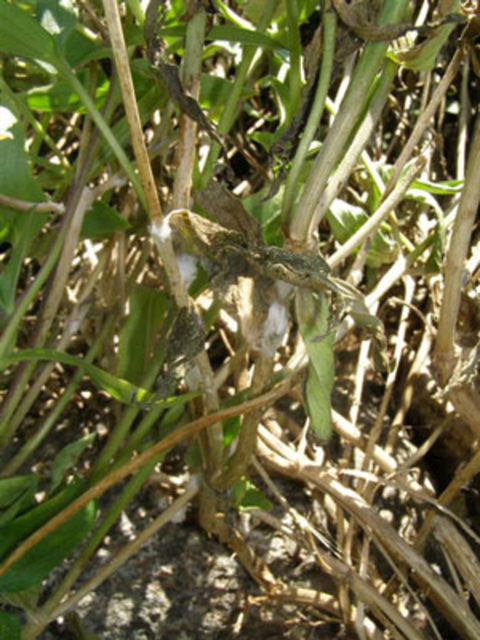Quick facts
- White mold is a disease that causes stem rot, wilt and death of many common flowers.
- Hard, resting structures, called sclerotia, allow the fungus to survive for many years. This lets the fungus reinfect gardens each year.
- Follow these critical steps to manage white mold:
- Inspect your garden often for signs of white mold.
- Remove and destroy infected plants right away.
How to identify white mold
Symptoms
- All leaves on one stem wilt and die.
- Infected parts of the stem are tan to off-white, dry and brittle.
- Stem tissue just above and below the infection often remain green.
- Fluffy, white, fungal growth may be seen on infected stems or leaves when humidity is high.
- Hard structures (called sclerotia) form on the surface of and within infected stems. These structures are:
- Black in color.
- Oblong to irregular in shape.
- About the size of a broken pencil tip.
Plants affected by white mold
The white mold fungus infects over 400 plant species.
Commonly affected flowering annual plants
- Petunia
- Zinnia
- Marigold
- Nicotiana
- Sunflower
- Salvia
Commonly affected garden vegetables
- Tomato
- Squash
- Bean
- Carrot
Commonly affected perennials
- Chrysanthemum
- Columbine
- Delphinium
- Peony
- Many common garden weeds
How does white mold survive and spread?
- White mold is caused by the fungus Sclerotinia sclerotiorum.
- The white mold fungus forms hard, black, resting structures called sclerotia. These structures are about the size of a broken pencil tip. Sclerotia allow the fungus to survive in the soil and plant debris for 5 or more years.
- In spring and summer when temperatures are cool (51 to 68 F) and the soil is moist, sclerotia produce a few tiny mushrooms. These mushrooms release spores that can travel up to a mile or more by wind.
- Spores that land on wounded or aging plant tissue, like old petals or leaves, will germinate and start an infection.
- Infections move into the main stem and eventually girdle it. When this happens, the leaves above the stem infection suddenly wilt and die.
- New sclerotia will begin to form on and within killed plant tissue.
How to manage white mold
Once white mold has been introduced to a garden, the disease often reoccurs each year. Several cultural control practices can help reduce the number of plants affected.
Reduce moisture on and around plants
- Choose plants with an upright and open form because they will dry more quickly than plants that lie along the ground or grow in dense clumps.
- Space plants far enough apart so air moves through them and dries them quickly.
- Use drip irrigation or soaker hose instead of sprinklers.
Clean up infected plants
- Remove all plants infected with white mold, as soon as the disease appears. Take care not to knock off any sclerotia in the process.
- Infected plants should be burned or buried in an area of the yard that will not be used for vegetable or flower gardening in the future.
- Infected plants can be composted only if the compost heats up to 148 to 158 F for a minimum of 21 days. If your home compost pile does not meet these standards, consider bringing infected plants to a municipal compost facility that does.
Use resistant plants
The plants below were evaluated for resistance by the University of Minnesota in 2011-2016.
Moderately resistant
In these plants, individual stems or shoots become infected and die back but the plant remains alive through the growing season.
- New Guinea Impatiens (Impatiens hawkerii)
- Pentas (Pentas lanceolata)
- Sweet Flag (Acorus granimeus)
Resistant
When grown in the garden, some stem infection could be found but plants did not wilt or die.
- Purple Millet Grass (Pennisteum glaucum)
- Elephant Ear (Colocasia esculenta)
- Canna (Canna x generalis)
Highly resistant
There are no symptoms of disease in these plants.
- Fiber Optic Grass (Scirpus sp.)
- Ornamental Reed (Juncus effusus)
- Ornamental Sedge (Carex flagellifera)
Reviewed in 2024




